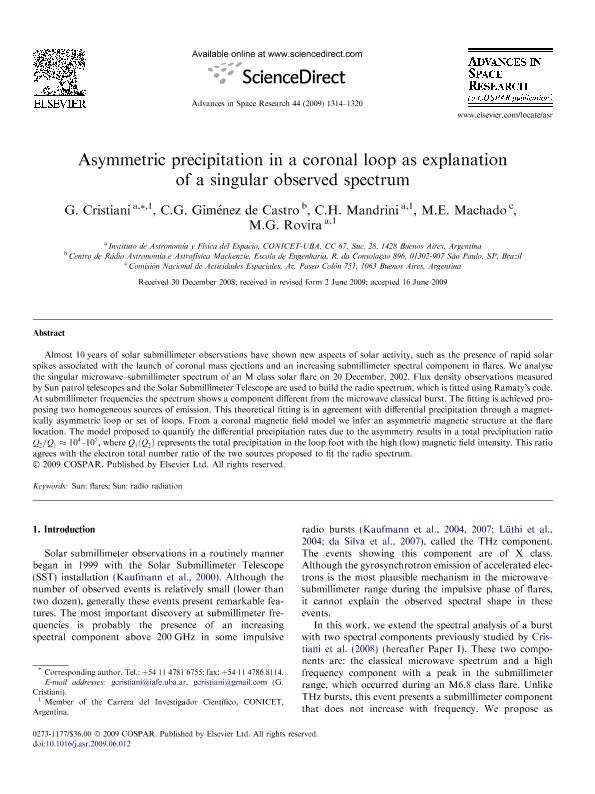Artículo
Asymmetric precipitation in a coronal loop as explanation of a singular observed spectrum
Cristiani, Germán Diego ; Giménez de Castro, C. G.; Mandrini, Cristina Hemilse
; Giménez de Castro, C. G.; Mandrini, Cristina Hemilse ; Machado, Marcos Emilio; Rovira, Marta Graciela
; Machado, Marcos Emilio; Rovira, Marta Graciela
 ; Giménez de Castro, C. G.; Mandrini, Cristina Hemilse
; Giménez de Castro, C. G.; Mandrini, Cristina Hemilse ; Machado, Marcos Emilio; Rovira, Marta Graciela
; Machado, Marcos Emilio; Rovira, Marta Graciela
Fecha de publicación:
11/2009
Editorial:
Elsevier
Revista:
Advances in Space Research
ISSN:
0273-1177
Idioma:
Inglés
Tipo de recurso:
Artículo publicado
Clasificación temática:
Resumen
Almost 10 years of solar submillimeter observations have shown new aspects of solar activity, such as the presence of rapid solar spikes associated with the launch of coronal mass ejections and an increasing submillimeter spectral component in flares. We analyse the singular microwave-submillimeter spectrum of an M class solar flare on 20 December, 2002. Flux density observations measured by Sun patrol telescopes and the Solar Submillimeter Telescope are used to build the radio spectrum, which is fitted using Ramaty´s code. At submillimeter frequencies the spectrum shows a component different from the microwave classical burst. The fitting is achieved proposing two homogeneous sources of emission. This theoretical fitting is in agreement with differential precipitation through a magnetically asymmetric loop or set of loops. From a coronal magnetic field model we infer an asymmetric magnetic structure at the flare location. The model proposed to quantify the differential precipitation rates due to the asymmetry results in a total precipitation ratio Q2/Q1≈104-105, where Q1(Q2) represents the total precipitation in the loop foot with the high (low) magnetic field intensity. This ratio agrees with the electron total number ratio of the two sources proposed to fit the radio spectrum.
Palabras clave:
Sol
,
Actividad
,
Eyecciones de Masa Coronal
,
Submilimetrico
Archivos asociados
Licencia
Identificadores
Colecciones
Articulos(IAFE)
Articulos de INST.DE ASTRONOMIA Y FISICA DEL ESPACIO(I)
Articulos de INST.DE ASTRONOMIA Y FISICA DEL ESPACIO(I)
Citación
Cristiani, Germán Diego; Giménez de Castro, C. G.; Mandrini, Cristina Hemilse; Machado, Marcos Emilio; Rovira, Marta Graciela; Asymmetric precipitation in a coronal loop as explanation of a singular observed spectrum; Elsevier; Advances in Space Research; 44; 11; 11-2009; 1314-1320
Compartir
Altmétricas



